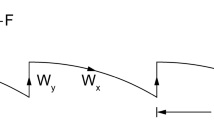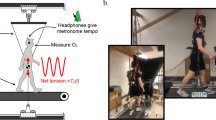Abstract
When an animal increases or decreases the frequency of its limb motions, how should the transformation in timing be characterized? It has been hypothesized that the transformation is adiabatic, even though the biological conditions are nonconservative and non-rate-limited (Kugler and Turvey 1987). An adiabatic transformation requires that the rhythmic system's action (energy/frequency) and entropy production remain time-invariant throughout the transformation. The non-conservative adiabatic hypothesis was evaluated through an experiment on human rhythmic hand movements. On each trial, a subject began at a prescribed frequency and then, over a 30 s interval, increased (or decreased) the frequency continuously at will. For each subject, on each increasing and decreasing trial, cycle kinetic energy was a linear function of cycle frequency with a negative energy intercept. By the adiabatic hypothesis, the slope of the function defines the constant action and the intercept defines the constant dissipation — changes in cycle frequency incur no changes in energy dissipated per cycle. Slopes and intercepts were correlated suggesting a common basis for the two constants, and the variety of cycle amplitude-cycle duration relations were in agreement with the nonmonotonic, nonlinear space-time function predicted by the hypothesis. The possibilities of addressing aspects of the data through (a) muscle modeled as a continuum of Kelvin bodies with a continuous relaxation spectrum, and (b) various classes of autonomous differential equations, were discussed. Most importantly, the discussion focused on the puzzling independence of energy cost and speed exhibited by locomoting animals differing in morphology, physiology, size, and taxa. It was suggested that the independence may reflect a very general principle — adiabatic transformability of biological movement systems.
Similar content being viewed by others
References
Andronov AA, Vitt AA, Khaikin SE (1987) Theory of oscillators. Dover, New York
Beek PJ, Beek WJ (1988) Tools for constructing dynamical models of rhythmic movement. Hum Mov Sci 7:301–342
Beek PJ, Turvey MT, Schmidt RC (1992) Autonomous and nonautonomous dynamics of coordinated rhythmic movements. Eco Psychol 4:65–96
Ehrenfest P (1959) Collected scientific papers. North-Holland, Amsterdam
Fung YC (1981) Biomechanics: Mechanical properties of living tissue. Springer, Berlin Heidelberg, New York
Full RJ (1989) Mechanics and energetics of terrestrial locomotion: Bipeds to polypeds. In: Weiser W, Gnaiger E (eds) Energy transformations in cells and organisms. Thieme Verlag, New York, pp 175–182
Grassberger P, Procaccia I (1983) Measuring the strangeness of strange attractors. Physica 9D:189–208
Iberall A (1990) A commentary on Kugler, Turvey, Schmidt and Rosenblum's ecological approach to motor systems. Eco Psychol 2:275–293
Jackson EA (1989) Perspectives of nonlinear dynamics. Cambridge University Press, Cambridge
Jordan DW, Smith P (1977) Nonlinear ordinary differential equations. Clarendon Press, Oxford
Kay BA (1988) The dimensionality of movement trajectories and the degrees of freedom problem: A tutorial. Hum Mov Sci 7: 343–364
Kay BA, Kelso JAS, Saltzman ES, Schöner G (1987) Space-time behavior of single and bimanual rhythmical movements. J Exp Psychol: Hum Perc Perf 13:178–192
Kay BA, Saltzman ES, Kelso JAS (1991) Steady state and perturbed rhythmical movements: A dynamical analysis. J Exp Psychol: Hum Perc Perf 17:183–197
Kram E, Taylor CR (1990) Energetics of running: A new perspective. Nature 346:265–266
Kugler PN, Turvey MT (1987) Information, natural law and the self-assembly of rhythmic movement. Erlbaum, Hillsdale
Kugler PN, Turvey MT, Schmidt RC, Rosenblum LD (1990) Investigating a nonconservative invariant of motion in coordinated rhythmic movements. Eco Psychol 2:151–189
Rankine WJM (1854) On the geometrical representation of the expansive action of heat and the theory of thermo-dynamic engines. Phil Trans R Acad London 144:155–175
Shaw RE, Kadar EE, Sim M, Repperger D (1992) The intentional spring: A strategy for modelling systems that learn to perform intentional acts. J Mot Beha 24:3–28
Schmidt RC, Beek PJ, Treffner PJ, Turvey MT (1991) Dynamical substructure of coordinated rhythmic movements. J Exp Psychol: Hum Perc Perf 17:635–651
Taylor CR, Schmidt-Nielsen K, Raab JL (1970) Scaling of the energetic cost of running to body size in mammals. Am J Physiol 219:1104–1107
Taylor CR, Heglund NC, Maloiy GMO (1982) Energetics and mechanics of terrestrial locomotion. I. Metabolic energy consumption as a function of speed and body size in birds and mammals. Exp Biol 97:1–21
Thompson JMT, Stewart HB (1986) Nonlinear dynamics and chaos. Wiley, Chichester
Turvey MT (1990) Coordination. Am Psychol 45:938–953
Walton M, Jayne NC, Bennett AF (1990) The energetic cost of limbless locomotion. Science 249:524–527
Author information
Authors and Affiliations
Rights and permissions
About this article
Cite this article
Kadar, E.E., Schmidt, R.C. & Turvey, M.T. Constants underlying frequency changes in biological rhythmic movements. Biol. Cybern. 68, 421–430 (1993). https://doi.org/10.1007/BF00198774
Received:
Accepted:
Issue Date:
DOI: https://doi.org/10.1007/BF00198774




